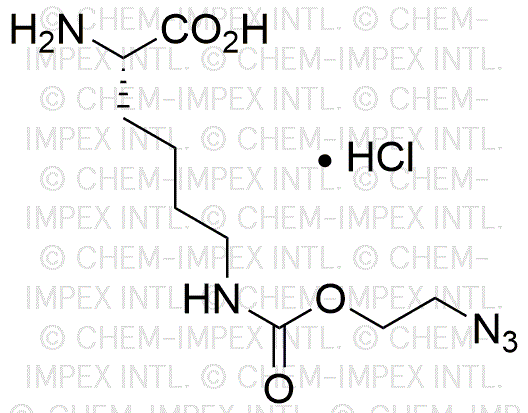Ne-((2-Azidoethoxy)carbonyl)-L-Lysine hydrochloride is widely utilized in research focused on:
- Bioconjugation: This compound serves as a versatile linker in bioconjugation processes, allowing researchers to attach biomolecules such as proteins and antibodies to surfaces or other molecules, enhancing the development of targeted therapies.
- Drug Development: It plays a crucial role in the synthesis of new pharmaceutical compounds, particularly in creating prodrugs that can improve the solubility and bioavailability of active ingredients.
- Protein Labeling: The azido group in this compound enables click chemistry, a powerful method for labeling proteins, which is essential in studying protein interactions and functions in cellular environments.
- Diagnostics: Its application in diagnostic assays allows for the development of sensitive detection methods, particularly in the field of immunoassays where precise labeling is critical for accuracy.
- Research in Neuroscience: This compound can be used in neuroscience research to study neuronal signaling pathways, providing insights into neurological disorders and potential therapeutic targets.
General Information
Properties
Safety and Regulations
Applications
Ne-((2-Azidoethoxy)carbonyl)-L-Lysine hydrochloride is widely utilized in research focused on:
- Bioconjugation: This compound serves as a versatile linker in bioconjugation processes, allowing researchers to attach biomolecules such as proteins and antibodies to surfaces or other molecules, enhancing the development of targeted therapies.
- Drug Development: It plays a crucial role in the synthesis of new pharmaceutical compounds, particularly in creating prodrugs that can improve the solubility and bioavailability of active ingredients.
- Protein Labeling: The azido group in this compound enables click chemistry, a powerful method for labeling proteins, which is essential in studying protein interactions and functions in cellular environments.
- Diagnostics: Its application in diagnostic assays allows for the development of sensitive detection methods, particularly in the field of immunoassays where precise labeling is critical for accuracy.
- Research in Neuroscience: This compound can be used in neuroscience research to study neuronal signaling pathways, providing insights into neurological disorders and potential therapeutic targets.
Documents
Safety Data Sheets (SDS)
The SDS provides comprehensive safety information on handling, storage, and disposal of the product.
Product Specification (PS)
The PS provides a comprehensive breakdown of the product’s properties, including chemical composition, physical state, purity, and storage requirements. It also details acceptable quality ranges and the product's intended applications.
Certificates of Analysis (COA)
Search for Certificates of Analysis (COA) by entering the products Lot Number. Lot and Batch Numbers can be found on a product’s label following the words ‘Lot’ or ‘Batch’.
Numéro de catalogue
Numéro de lot/série
Certificates Of Origin (COO)
This COO confirms the country where the product was manufactured, and also details the materials and components used in it and whether it is derived from natural, synthetic, or other specific sources. This certificate may be required for customs, trade, and regulatory compliance.
Numéro de catalogue
Numéro de lot/série
Safety Data Sheets (SDS)
The SDS provides comprehensive safety information on handling, storage, and disposal of the product.
DownloadProduct Specification (PS)
The PS provides a comprehensive breakdown of the product’s properties, including chemical composition, physical state, purity, and storage requirements. It also details acceptable quality ranges and the product's intended applications.
DownloadCertificates of Analysis (COA)
Search for Certificates of Analysis (COA) by entering the products Lot Number. Lot and Batch Numbers can be found on a product’s label following the words ‘Lot’ or ‘Batch’.
Numéro de catalogue
Numéro de lot/série
Certificates Of Origin (COO)
This COO confirms the country where the product was manufactured, and also details the materials and components used in it and whether it is derived from natural, synthetic, or other specific sources. This certificate may be required for customs, trade, and regulatory compliance.


